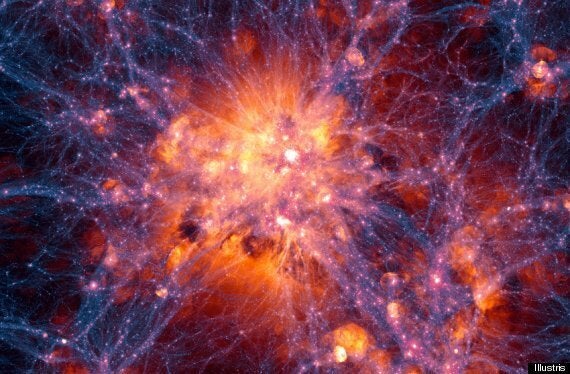Physicists have built the first genuinely convincing artificial universe in a computer.
And there's an outside chance this remarkable breakthrough could have influence debate on whether we too reside inside a machine.
The researchers from MIT and the Harvard-Smithsonian Center for Astrophysics, the Heidelberg Institute for Theoretical Studies and others, created the large-scale universe using a computer model called 'Illustris'.
The model allowed them to recreate 13 billion years of cosmological expansion and evolution, inside a virtual cube with sides 350-million light years wide.
The high-resolution model accounts for both normal and 'dark' matter, the latter of which is thought to make up most of the mass of the universe despite the fact we can't actually see it. (At least not yet).
Illustris was able to surpass previous attempts to make a model of this size, incorporating feature such as black holes, supernovas and the formation of stars.
But the new model, which took five years to develop and three months to build in the machine, with 8,000 CPUs running at once, is a huge step forward.
The team said an average desktop PC would take 2,000 years to create something on the same scale.
At the end of the simulation the researchers counted 41,000 galaxies, including a realistic mix of spiral and football-shaped galaxies, as well as galaxy clusters, bubbles and voids on the larger scale. It was also able to recreate the chemical composition of smaller galaxies.

Above: a view of Illustris
"Illustris is like a time machine. We can go forward and backward in time. We can pause the simulation and zoom into a single galaxy or galaxy cluster to see what's really going on," says co-author Shy Genel of the CfA.
The study was published in Nature on 8 May.
It's not just physicists and cosmologists interested in making models of the universe - it's philosophers too. A thought experiment has long held that if a simulation of the universe is possible on a rich enough scale, then it would be overwhelmingly likely that we live inside one such model - or a model within a model - than the one original.
While this is mainly a way to illustrate the absurdity of probabilities, it is increasingly seen as at least a vague possibility. Recent studies which found emergent (and not programmed) similarities in small-scale models and our own universe tentatively suggested there may be something in the theory after all.
Let's just hope whoever is running the simulation doesn't trip over the plug.